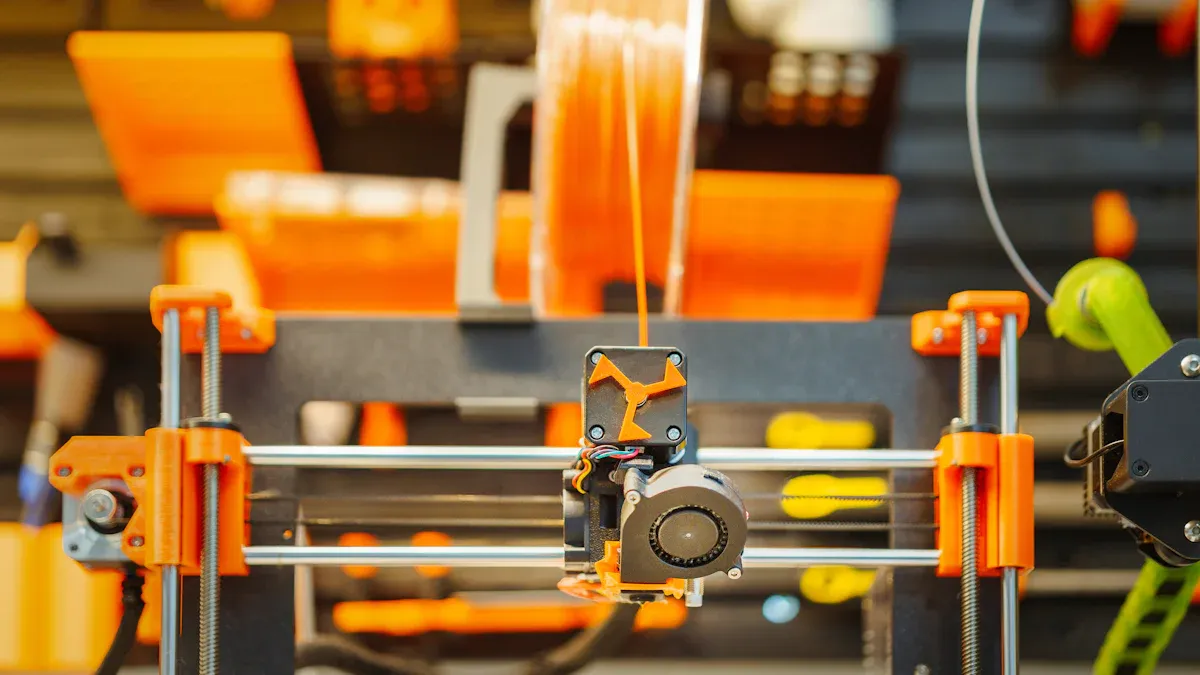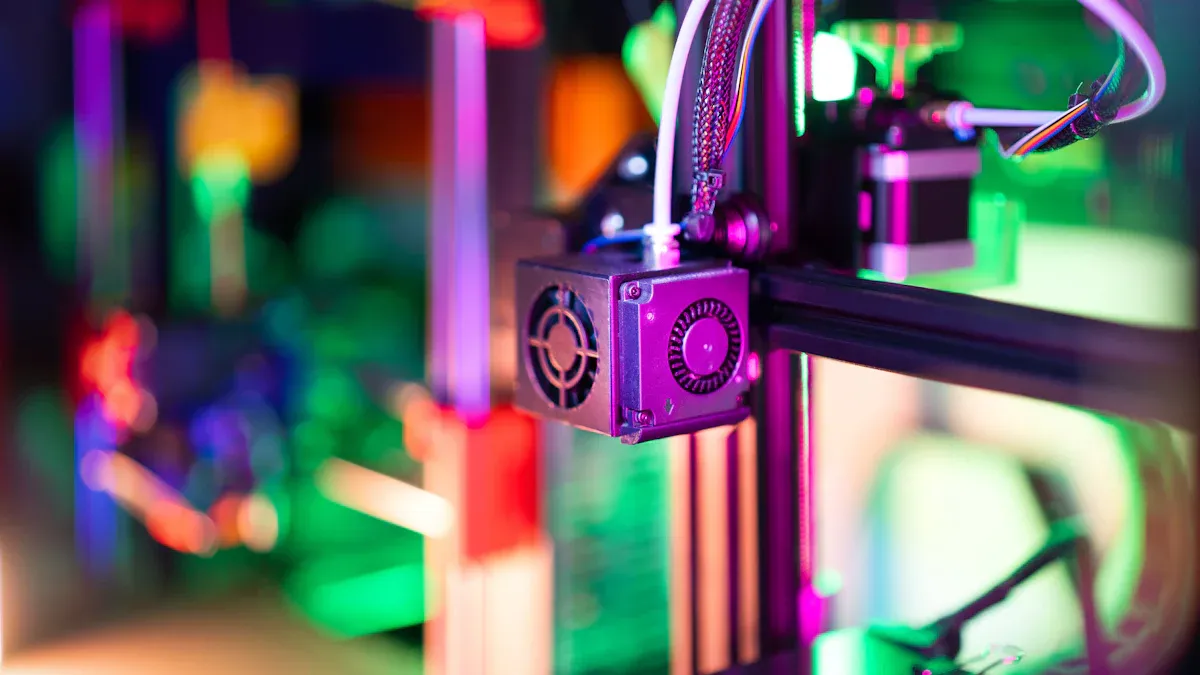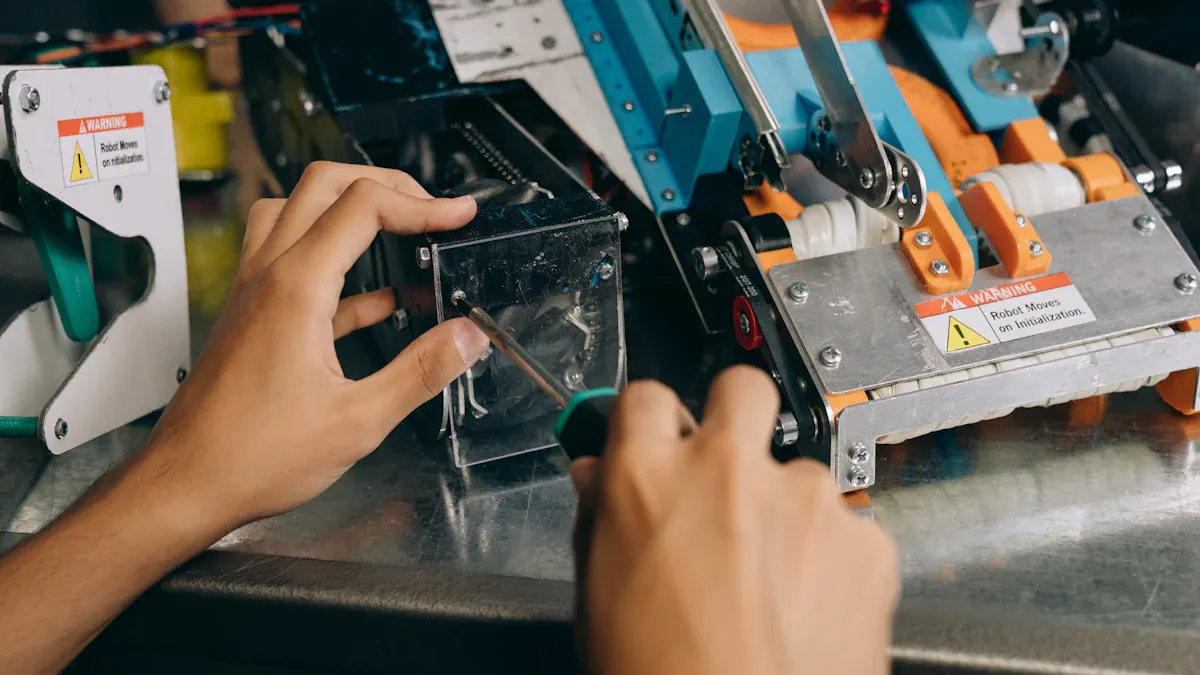
Operators notice that PVC Pipe and Profile Designed for Extruders Conical Twin Screw Barrel systems face wear from strong separating forces and long-term use, especially with filled PVC. Advanced treatments like nitriding boost abrasion resistance. Pc Blowing Bottle Machine Manufacturers and Pvc Pipe Single Screw Barrel users also benefit from regular checks on Twin-Screw Extruder Screw Barrels.
Why Wear Occurs in PVC Pipe and Profile Designed for Extruders Conical Twin Screw Barrel

Main Causes of Wear
Wear in PVC Pipe and Profile Designed for Extruders Conical Twin Screw Barrel systems results from several mechanical and chemical factors. Abrasive fillers such as calcium carbonate, glass fibers, and talc in the PVC compound increase friction inside the barrel. These hard particles rub against the screw and barrel surfaces, especially at high pressures and temperatures, leading to faster abrasion. Corrosive wear also develops when additives or degraded polymer particles chemically attack the metal surfaces, particularly in zones with elevated temperatures and longer residence times.
Mechanical issues play a significant role. Poor barrel alignment, improper clearance between the screw and barrel, and momentary blockages can cause side forces that push the screw against the barrel wall. This increases localized wear. Uneven heating of the barrel may cause thermal expansion and warping, further contributing to wear. Overloads from foreign objects or improper material processing can also accelerate damage.
Tip: Regular inspection and precise machine setup help reduce these risks and extend the lifespan of the conical twin screw barrel.
| Design Feature | Impact on Wear Reduction and Material Processing |
|---|---|
| Conical Barrel Geometry | Optimizes material flow, reducing resistance and uneven wear. |
| Twin Screw Mechanism | Ensures uniform mixing, lowering localized stress and wear. |
| High-Quality Materials | Enhances surface hardness and corrosion resistance, extending barrel life. |
| Precise Temperature Control | Prevents overheating, reducing thermal degradation and wear. |
| Modular Screw Design | Allows adjustment for specific formulations, minimizing wear. |
Effects on Extrusion Performance
Wear in the conical twin screw barrel directly affects extrusion performance. Increased clearance between the screw flights and barrel reduces output, as the system loses its ability to move material efficiently. This can lead to lower throughput and higher energy consumption. Wear may also cause deflection and bending of the screws, known as the banana roll effect, which puts uneven forces on bearings and can result in operational inefficiencies.
Operators may notice longer startup times, material backup, and a burnt material smell. These symptoms indicate that the PVC Pipe and Profile Designed for Extruders Conical Twin Screw Barrel is not functioning optimally. Excessive wear can even lead to screw breakage, directly impacting production efficiency and product quality. Regular maintenance, use of wear-resistant materials, and proper screw design help maintain consistent extrusion performance and high-quality output.
Preventative Maintenance for Conical Twin Screw Barrels

Regular Cleaning Procedures
Regular cleaning plays a vital role in extending the life of conical twin screw barrels. Operators should focus on cleaning areas that collect residue and buildup. Many modern extruders, such as those with swing-gate strand-die assemblies or EasyClean modules, allow quick access to critical regions. These features reduce cleaning time by up to 40%, making it easier to maintain the equipment and minimize downtime.
- Routine cleaning is recommended every 500 to 1,000 operating hours.
- Purging with suitable resins or specialized purge materials removes residue and prevents contamination.
- Consistent cleaning helps maintain extruder performance and product quality.
Tip: Easy access to screws and dies during cleaning not only saves time but also reduces the risk of wear and maintenance delays.
Lubrication and Cooling System Care
Proper lubrication and cooling are essential for the smooth operation of the PVC Pipe and Profile Designed for Extruders Conical Twin Screw Barrel. High-quality alloy steel and surface treatments like nitriding or bimetallic cladding improve wear resistance. Cooling systems, such as water or oil circulation, regulate barrel temperature, while electric heaters and heating/cooling jackets maintain the correct melt temperature.
| Aspect | Details |
|---|---|
| Barrel Material | High-quality alloy steel providing strength and durability |
| Surface Treatment | Nitriding, bimetallic cladding to enhance wear resistance |
| Cooling Systems | Water or oil circulation systems to regulate barrel temperature |
| Heating Systems | Electric heaters, heating/cooling jackets to maintain melt temperature |
Insufficient lubrication can cause gear wear, bearing damage, and abnormal noise. Poor cooling may lead to overheating, oil aging, and high bearing temperatures. These issues accelerate wear, cause abnormal vibrations, and reduce the lifespan of the equipment. Regular inspection and maintenance of lubrication and cooling systems help prevent these problems.
Inspection and Clearance Checks
Routine inspection and clearance checks are crucial for preventing severe wear or failure in conical twin screw barrels. Maintaining the clearance between the screw and barrel within a specified limit—about 1/1000 of the scale—prevents excessive wear.
- If the gap becomes too large, melt can flow back into the threads, which accelerates wear on both the screw and barrel.
- Proper clearance avoids direct metal-to-metal contact, preventing thread damage or seizure.
- Regular preventive maintenance inspections monitor this clearance, enabling timely repairs or rebuilds before severe wear occurs.
Note: This approach reduces resin waste, maintains productivity, and extends the lifespan of the PVC Pipe and Profile Designed for Extruders Conical Twin Screw Barrel.
Replacing Worn Parts
Processors should closely monitor wear and hazards affecting the PVC Pipe and Profile Designed for Extruders Conical Twin Screw Barrel. Even minimal wear on screws and barrels can impact product quality. Regular checking and measurement are necessary. Replacement or reinstallation of screws should be considered based on these inspections rather than fixed wear thresholds.
Signs that indicate the need to repair or replace include decreased extrusion consistency, increased resin leakage, and higher energy consumption. Professional assessment using advanced diagnostic techniques, such as ultrasonic testing and metallurgical analysis, helps evaluate wear extent. Repair involves precision machining, recoating, and testing to restore or improve screw performance. Decisions on replacement versus repair depend on performance degradation and expert evaluation.
Operational Best Practices for PVC Extrusion
Start-Up and Shut-Down Procedures
Operators should follow precise steps during start-up and shut-down to protect the conical twin screw barrel.
- Inspect the extruder for proper alignment and check that all safety devices function correctly.
- Gradually heat the barrel zones to the recommended temperature profile.
- Start the screw rotation at a low speed to ensure smooth material flow and prevent sudden pressure spikes.
- Purge the system with suitable resin to remove any residual material.
- During shut-down, reduce screw speed, lower temperatures, and continue purging until the barrel is clean.
- Turn off heaters and allow the system to cool before stopping all motion.
Proper start-up and shut-down routines help minimize thermal shock and mechanical stress, reducing wear on the PVC Pipe and Profile Designed for Extruders Conical Twin Screw Barrel.
Material Handling and Preparation
Careful material handling prevents abrasive wear and extends equipment life.
- Operators should monitor all raw materials for contaminants and abrasive fillers like glass fibers or talc.
- Use wear-resistant screws and barrels when processing abrasive compounds.
- Check screw straightness and alignment before installation.
- Compare new and old screws for compatibility.
- Slide the screw into the barrel and rotate by hand to confirm smooth movement.
- Align the extruder machine before running new parts to avoid uneven wear.
- Establish preventive maintenance programs with regular inspections and timely replacement of worn components.
Temperature and Pressure Management
Maintaining correct temperature and pressure is essential for efficient extrusion.
- Adjust temperature setpoints in each barrel zone to soften resin and reduce mechanical energy input.
- Monitor barrel temperature and discharge pressure to prevent overheating or pressure spikes.
- Avoid underheating, which can cause poor plasticization and force the screw to work harder.
- Prevent pressure fluctuations and ensure even material flow to reduce localized wear.
- Use calibrated thermocouples and optimal cooling to maintain stable processing conditions.
Consistent temperature and pressure management help prevent premature wear and maintain high product quality.
Troubleshooting and Early Detection of Wear
Identifying Early Wear Signs
Early detection of wear in conical twin screw barrels helps prevent costly repairs and downtime. The first signs often appear as flight erosion, pitting, or corrosion on the screw and barrel surfaces. These issues result from abrasive fillers, metal-to-metal contact, or chemical reactions during PVC extrusion. Operators can spot these problems through regular visual inspections. Precision tools, such as flight depth gauges and bore micrometers, measure wear accurately. Most experts recommend checking the equipment every three to six months. This routine helps catch problems before they lead to major failures in the PVC Pipe and Profile Designed for Extruders Conical Twin Screw Barrel.
Responding to Abnormal Noises or Vibrations
Unusual noises or vibrations often signal mechanical issues inside the extruder. Operators should listen for grinding, knocking, or rattling sounds during operation. These noises may indicate misalignment, bearing failure, or excessive clearance between the screw and barrel. Vibration sensors and smart monitoring systems can detect these changes early. When operators notice abnormal sounds or vibrations, they should stop the machine and inspect all moving parts. Quick action prevents further damage and extends equipment life.
Tip: Smart sensors that monitor temperature, vibration, pressure, and screw speed provide real-time alerts for early wear detection. Integration with IoT and machine learning enables predictive maintenance, reducing downtime and unnecessary repairs.
Monitoring Product Quality
Product quality often reflects the condition of the conical twin screw barrel. Operators may notice increased scrap rates, uneven mixing, or visible defects in the extruded product. Metal dust or foreign particles in the output suggest internal erosion. Worn screws can cause uneven heat transfer, leading to overheating or poor melting. These problems result in lower output, higher energy use, and frequent machine shutdowns. Regular monitoring of product quality helps identify wear issues early and maintain consistent production standards.
Quick-Reference Checklist for Wear Prevention
A structured checklist helps operators maintain conical twin screw barrels and prevent premature wear. Regular use of this list ensures consistent performance and reduces unexpected downtime.
Daily and Weekly Maintenance
- Inspect the machine for visible damage or defects.
- Verify that safety guards and emergency stop buttons work correctly.
- Monitor extrusion temperature settings and process speed.
- Lubricate moving parts, including the gearbox and screw.
- Check for abnormalities in the extruded product, such as bubbles or unevenness.
- Clean the cooling system to prevent overheating.
- Inspect for leaks, electrical issues, and loose connections.
Operational Best Practices
- Prevent metal or foreign objects from entering the hopper. Use metal detectors and screen materials before feeding.
- Avoid running the extruder empty to reduce screw and barrel wear.
- Operate the screw at low speed during cleaning to minimize friction.
- After cleaning, use compressed air to remove residual pellets and powder from feeding and exhaust ports.
- Stop the extruder and close main power and cold water valves after cleaning.
Safety and Assembly
- Handle heavy parts with proper lifting equipment during assembly and disassembly.
- Protect pressure sensors with covers when not in use. Avoid using hard objects to clean sensor diaphragms.
- Perform safety checks before starting and stopping operations.
Tip: Integrate this checklist into daily, weekly, and monthly routines. Consistent use improves equipment reliability and extends the life of the conical twin screw barrel.
Consistent maintenance, correct operation, and early detection keep conical twin screw barrels running smoothly.
- Regular inspections, cleaning, and lubrication extend equipment life and reduce costly repairs.
- Weekly use of the checklist helps spot wear early, supporting reliable, high-quality PVC extrusion.
- Facilities report less downtime and improved efficiency with these strategies.
FAQ
How often should operators inspect conical twin screw barrels?
Operators should inspect conical twin screw barrels every three to six months. Regular checks help detect early signs of wear and maintain consistent extrusion quality.
What materials help reduce wear in conical twin screw barrels?
Manufacturers use high-quality alloy steel and apply surface treatments like nitriding. These materials increase hardness and resist abrasion during PVC extrusion.
Can early wear affect product quality?
Yes. Early wear can cause uneven mixing, lower output, and visible defects in the final product. Regular monitoring ensures high-quality PVC extrusion results.
Post time: Jul-21-2025
